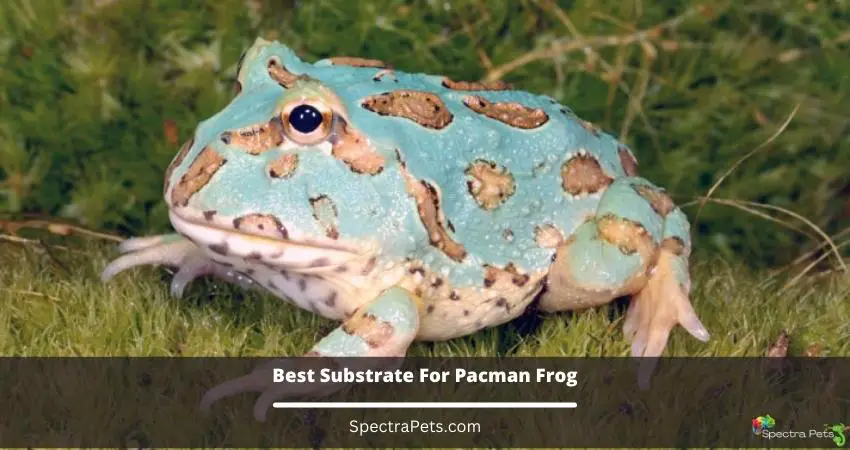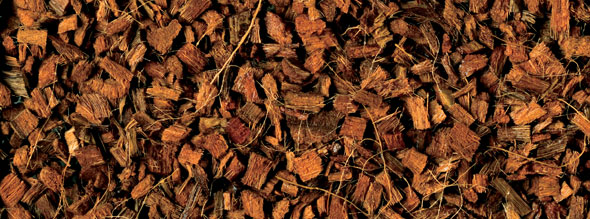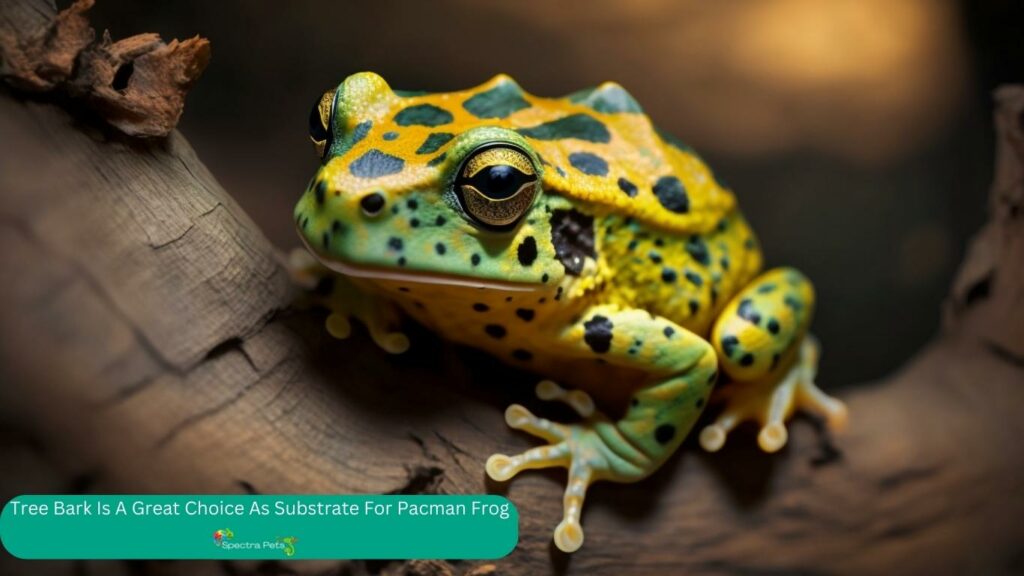Pacman frogs are one of the most popular pet frogs, and for good reason- They’re cute, funny, and relatively low maintenance. As soon as you acquire a Pacman frog, you must ensure you provide him/her with the best living environment possible. And, one of the most important components of its environment is the substrate.
Now, as a new Pacman frog owner, you’re probably wondering what the best substrate is for your new pet. Since these frogs need a moist and humid environment to thrive in, it’s essential that you provide them with a top-notch substrate that will keep them comfortable.
Well, there are multiple types of substrates you can use for your frog’s habitat, but some work better than others. Let’s have a look at some of the finest Pacman frog substrates before you make your decision.

6 Best Substrates For Pacman Frog
Substrates are considered bedding for frogs and picking the right substrate or combination of substrates for your Pacman frog is important. In addition to affecting humidity levels and health, the substrate will also create a naturalistic environment for your frog. Here are six of the best substrates you can use for your Pacman frog.
1. Coconut Husk
One of the best substrates you can use for your Pacman frog is coconut husk. Coconut husk is an excellent substrate for a number of reasons. First, it’s highly absorbent, which means it will help to keep the humidity levels in your frog’s habitat high.

Due to the heaviness of the coconut husk, it isn’t a great substrate for burrowing. However, your frog can easily do digging if it needs to. Also, the sharp edges of the coconut husk can be harmful to your frog. So, in my opinion, this particular substrate is not ideal for baby Pacman frogs.
If you are interested in using coconut husk as your frog’s substrate, Prococo Premium Coconut Husk is an excellent choice. It is completely safe for your frog as it’s 100% organic and doesn’t contain any chemicals or pesticides. Also, this eco-friendly substrate won’t let mold and mildew grow in your frog’s habitat. So, you can trust Prococo to provide your Pacman frog with odorless and healthy bedding.
2. Coconut Fiber
Another great substrate you can use for your Pacman frog is coconut fiber. Coconut fiber is very similar to coconut husk, but it’s a bit finer and smaller. As it’s a bit finer, it’s more comfortable for your frog to burrow in.
Coconut fiber is also very absorbent, which means it will help to keep the humidity levels in your frog’s habitat high. Impaction is also not an issue with this substrate as the coconut fiber is too fine to ingest. The best part of this type of frog bedding is that it’s super easy to maintain. All you need to do is change the substrate once every month to ensure a fresh environment for your frog.
If you’re looking for a high-quality coconut fiber substrate, I can suggest two products so that you can choose one according to your budget.

If you want your little croaking friend a natural habitat, then Zoo Med Eco Earth is perfect for you as it’s made from compressed coconut fiber. This product is entirely natural, which makes it safe for your frog. It’s also very absorbent, so it will help to keep the humidity levels in your frog’s habitat high. You don’t have to take the hassle of changing this substrate frequently as it lasts long.

If you’re looking for a coconut fiber substrate that’s a bit more affordable, Exo Terra is a great choice. This substrate is also made from coconut husk, so it’s completely natural and safe for your frog. Not only does it make your frogs feel more comfortable by stimulating their natural digging and burrowing behavior, but it’s also a budget-friendly way of ensuring that the humidity in their terrarium stays high.
3. Moss
For improving the humidity of your Pacman frogs enclosure, you can use moss as a covering for the substrate. With exceptional moisture retention abilities, moss is ideal for providing an optimal humidity level inside the terrarium.
Sphagnum moss, in particular, is an excellent choice as it’s very absorbent. Not only will Sphagnum moss help to keep the humidity levels in your frog’s habitat high, but it will feel more natural. Your frog will enjoy hiding and sleeping within the moss since there are no sharp edges to worry about.
However, you should keep in mind that moss can’t be the solo substrate for your frog’s terrarium as it doesn’t provide enough support. So, you need to mix it with other substrates like coconut fiber or husk. Also, don’t cover the feeding zone with moss as swallowing it can cause severe health issues for your Pacman frog.
Here are 2 products that I can suggest if you’re looking for moss for your Pacman frog’s terrarium.
If you want your Pacman frog to enjoy a natural environment, then Zoo Med Nature Moss is an ideal choice for you. It’s a completely natural product that stays moist for a long time. With high absorbency, this lush carpet-like moss creates a humid condition inside the terrarium, which is perfect for your frog. Above all, you can easily wash and reuse it several times which will save you some money in the long run.
Here’s another fantastic long fiber sphagnum moss substrate for your Pacman frog. This moss is also 100% natural and perfect for creating a humid and frog-friendly environment inside the terrarium. Moreover, this fully natural forest moss also looks great, and your frog will love burrowing and digging through it. With high moisture-retaining abilities, this substrate is ideal for keeping the humidity levels in your frog’s habitat high.
4. Tree Bark
Pacman frogs do well when housed on a substrate that is both moisture retentive and porous. Tree bark is a great choice for this, as it helps to keep the frog’s environment moist while still providing plenty of airflow. In addition, most of the tree bark is made from fir trees. So, it is a natural material that will help to create a more naturalistic habitat for your pet frog.

Though this type of substrate is larger than coconut fiber, it is good for burrowing and digging. Moreover, don’t put the tree bark where your frog eats and hides as it might cause impaction due to its sharp edges. However, with less maintenance hassle, tree bark is an excellent substrate for your pet Pacman frog.
Here are 2 of the best tree bark for Pacman frogs:
a) Exo Terra Forest Bark: This is an all-natural substrate made from fir tree bark. It is ideal for moisture retention and drainage, and it’s reusable too. The most amazing part is that it is 100% eco-friendly. So, your frog’s habitat will have a naturalistic tropical rainforest look. You can clean this product easily using hot water, and you should do so every 2-3 months. It will last up to 1 year.
b) Zoo Med Fir Bark: This substrate is also made of fir tree bark and it has a similar look and feel to the Exo Terra product. It is great for moisture retention, drainage, and burrowing. The fir bark also aids in creating humidity, making it a perfect naturalistic substrate for Pacman frogs. It promotes natural digging and burrowing behaviors in these frogs. Like Exo Terra bark, it also has a 1-year lifespan, and you can wash and clean it with hot water.
5. Leaf Litter
To create a forest vibe, you can add some leaves on top of the substrate of your Pacman frog’s terrarium. Be sure to only use leaves that are safe for your frog, such as Oak or Maple leaves. Do not use leaves from Poison Ivy, Poison Oak, or Poison Sumac as these can be harmful to your frog. You can find these leaves in your backyard or at a park.

Though leaf isn’t mandatory, it will create a welcoming forest floor look in your Pacman frog’s habitat. Moreover, creating hiding places for your frogs out of leaf litter is a great way to make them feel more comfortable in captivity, as they would usually hide beneath leaves in the wild. Apart from that, this will help your frog remain active by improving the humidity inside the tank.
If you’re looking for an easier way to get leaf litter for your Pacman frog, here are two of the best options available commercially:
- XYZReptiles Premium Oak Leaf Litter: This substrate is made of oak leaves that are completely natural. Also, it’s chemical-free, so it is safe for your frog. The leaves are collected, processed, and packaged in the United States. This leaf litter traps humidity efficiently, making it perfect for Pacman frogs.
- SunGrow 50-Pack Leaf Litter: If you want a bigger quantity of leaf litter, this 50-pack from SunGrow is a great choice. The Mini Catappa Indian Almond leaves will help to create a real forest feel inside your Pacman frog’s terrarium. These leaves keep the substrate temperature and moisture level constant.
6. Aquarium Gravel
Aquarium gravels can be the best type of substrate for temporary housing. In other words, when you don’t want to spend too much money on the substrate and if you only need it for a short period, aquarium gravel can be a great choice. It is very cheap, and it can be found in any pet store.
However, you can’t use this substrate for your frog’s permanent housing as it comes with high impaction risks. The small sharp edges of aquarium gravel can cause intestinal blockage if your frog ingests it.
In my opinion, the following gravel is best suited for temporary housing:
- Pure Water Pebbles Aquarium Gravel: This is a popular gravel product that is good for Pacman frogs. The pebbles are non-toxic, so you don’t have to worry about your frog being harmed by them. They are also very smooth, so there is less risk of impaction compared to other low-quality gravels.
Things to consider while buying substrate for Pacman frog
Pacman frogs are one of the most popular pet frogs among amphibian lovers. They are relatively easy to care for and make great pets. Here are the five basic things you need to consider while buying substrate for Pacman frog.
1. Size of the frog’s enclosure
The substrate you buy should be able to cover the entire bottom part of the frog’s enclosure. Frogs like to burrow and hide, so you need to make sure there is enough substrate for your frog to do so.
2. Natural-looking substrate
Frogs are natural-born predators. In the wild, they would spend most of their time looking for food. If you want your frog to feel at home, it is best to get a substrate that looks like its natural habitat.
3. Easy to maintain
The substrate you choose should be easy to maintain. You don’t want to spend hours cleaning the frog’s enclosure every week. Look for a substrate that is easy to clean and doesn’t require too much maintenance.
4. Safe for the frog
The safety of the frog is crucial. Some substrates can be harmful to frogs if they ingest them. And some have sharp edges that can hurt the frog. So, be sure to choose a substrate that is safe for your frog.
5. Humidity and temperature
The substrate should be able to maintain the humidity and temperature of the frog’s enclosure. Frogs are sensitive to changes in temperature and humidity, so it is important to choose a substrate that can regulate these factors.
Now that you know the things to consider while buying substrate for Pacman frog, be sure to keep these factors in mind while making your purchase.
Do I need to do anything special to prepare or sterilize my substrate before using it?
It is important to sterilize your substrate before using it, especially if you are using it for Pacman frogs. In the following section, I will discuss the sterilization processes of all 6 types of substrates I’ve discussed above.
Coconut Husk Preparation Process
Coconut husk must be prepared before being used inside your frog terrarium. For that, submerge the desired amount of husk in the water right after unpacking. Wait until all the dry pieces break up and fully expand. Finally, drain the leftover water and pour the substrate into the frog’s habitat’s bottom part.
Coconut Fiber Preparation Process
Just like coconut husk, you have to soak coconut fiber in water first. After a while, Coconut Fiber turns into mud-like stuff by absorbing moisture. Now, you can use it as a substrate.
Moss Preparation Process
You can prepare moss very easily, and it absorbs a lot of water. To prepare moss, soak the desired amount of moss in water.
Before placing it in the enclosure, gently squeeze it a few times to maximize the amount of liquid it absorbs.
Leaf Litter Preparation Process
Inspecting leaves for insects and thoroughly rinsing them is the first step. Right after cleaning them, take fresh water and submerge the leaves in water for some time before putting them into the frog tank. It will provide a more natural appearance inside the terrarium.
Tree Bark Preparation Process
In order to use tree bark, soak it in hot boiled water for 15 – 30 minutes. The tree barks are then ready to be placed inside the frog tank.
Aquarium Gravel Preparation Process
There are many loose particles in aquarium gravel; for this reason, you should keep rinsing the gravel until all loose particles have been removed.
Is it possible to combine different substrates in a terrarium?
For many Pacman frog enthusiasts, the appeal of terrariums lies in their ability to replicate a frog’s natural habitat. This typically involves creating a space that is humid and warm, with plenty of hiding places for the frog to feel secure.
In terms of substrate, though it is possible to use just one type of substrate, many frog enthusiasts prefer to mix and match different types to create a more naturalistic habitat for their frogs. The majority of the time, people mix coconut fiber and moss. The coconut fiber helps to create a humid environment while the moss retains moisture and adds a bit of padding for the frog.
So, in general, it is safe to combine different types of substrates as long as they don’t occupy too much space and cause any issue for your captivated frog.
Frequently Asked Questions (FAQ)
What is the best substrate for Pacman frogs?
What is the minimum substrate depth for a Pacman frog?
How often should I replace the substrate?
Is it possible to reuse the substrate of your frog’s enclosure?
Can I use sand or gravel as a substrate for my Pacman frog?
What other items should I include in the enclosure besides the substrate?
How do I maintain the right humidity level in the enclosure?
What temperature should the enclosure be for Pacman frogs?
Can Pacman frogs eat the substrate?
Can I use paper towels or newspaper as a substrate for my Pacman frog?
Final Words
So, if you are considering a Pacman frog as a pet and want to provide the best environment for him (or her!) remember to give plenty of space and make sure that you have provided the best substrate for this little amphibian.
By following the aforementioned information, you can help ensure that your new pet lives a long, healthy, and comfortable life. Have you ever kept a Pacman frog? What advice would you add based on your own experience? Feel free to add your valuable thoughts in the comment section.
